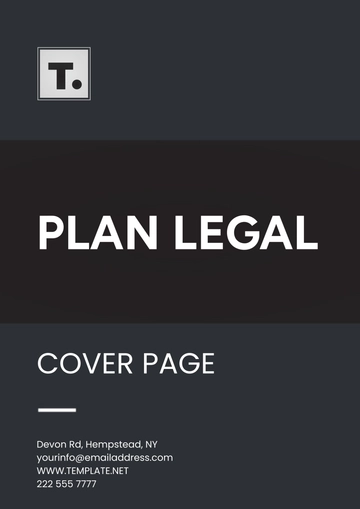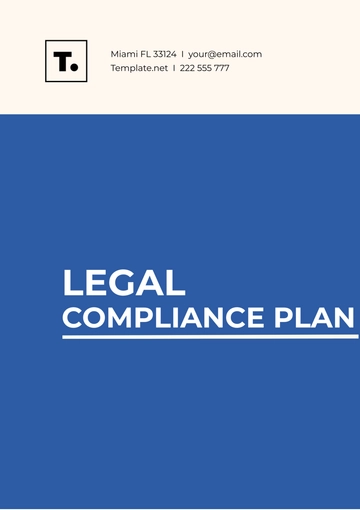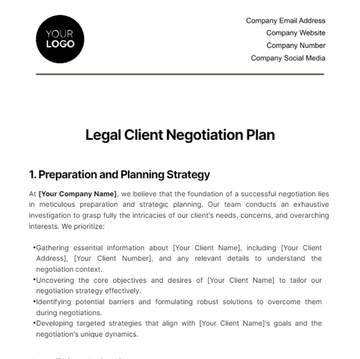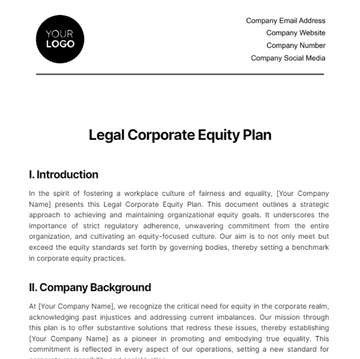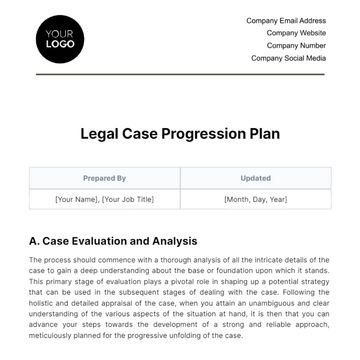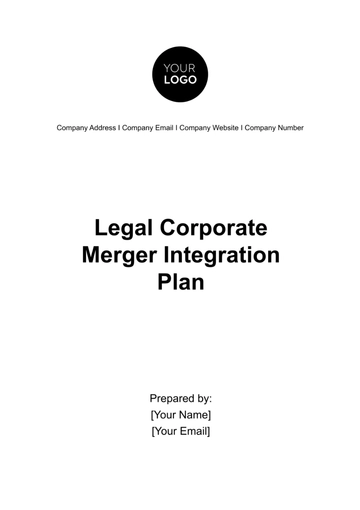Free Legal Corporate Equity Plan
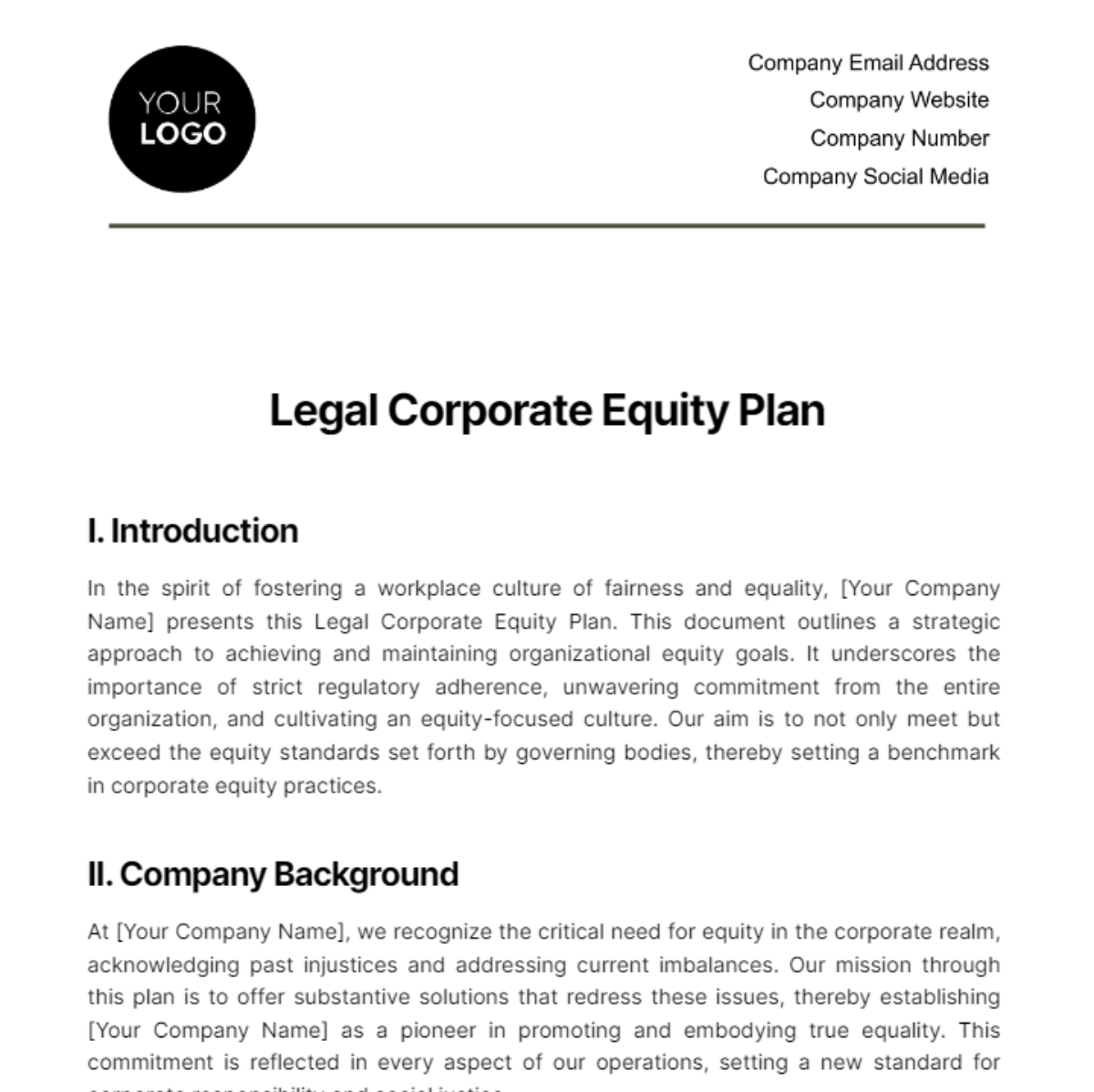
I. Introduction
In the spirit of fostering a workplace culture of fairness and equality, [Your Company Name] presents this Legal Corporate Equity Plan. This document outlines a strategic approach to achieving and maintaining organizational equity goals. It underscores the importance of strict regulatory adherence, unwavering commitment from the entire organization, and cultivating an equity-focused culture. Our aim is to not only meet but exceed the equity standards set forth by governing bodies, thereby setting a benchmark in corporate equity practices.
II. Company Background
At [Your Company Name], we recognize the critical need for equity in the corporate realm, acknowledging past injustices and addressing current imbalances. Our mission through this plan is to offer substantive solutions that redress these issues, thereby establishing [Your Company Name] as a pioneer in promoting and embodying true equality. This commitment is reflected in every aspect of our operations, setting a new standard for corporate responsibility and social justice.
III. Equity Policy Creation
The foundation of our approach to equity is the establishment and rigorous implementation of a written equity policy. This policy serves as a testament to [Your Company Name]'s dedication to fostering an inclusive environment, guiding every facet of our business operations. Our comprehensive process includes:
Policy Research & Benchmarking: Conducting extensive research and drawing insights from industry benchmarks to ensure our policy is aligned with best practices and legal standards.
Drafting the Policy: Crafting a policy that is both comprehensive and reflective of [Your Company Name]'s core values and commitment to equity.
Policy Review and Approval: A meticulous review process involving key stakeholders to ensure the policy's effectiveness and alignment with organizational objectives.
Policy Communication and Training: Ensuring widespread understanding and integration of the policy through targeted communication strategies and comprehensive training programs.
Regular Policy Review: Committing to ongoing evaluations and updates of the policy to address evolving equity challenges and legislative changes.
IV. Compliance with Laws and Regulations
Adherence to legal standards is non-negotiable. [Your Company Name] is committed to full compliance with all relevant laws and regulations, including but not limited to:
Law/Act | Description |
|---|---|
Civil Rights Act | Ensuring no employment discrimination based on race, color, religion, sex, or national origin. |
Americans with Disabilities Act | Guaranteeing equal opportunities for individuals with disabilities. |
Equal Pay Act | Advocating for gender pay equity. |
Age Discrimination in Employment Act | Protecting the rights of employees aged 40 and above. |
Pregnancy Discrimination Act | Prohibiting discrimination based on pregnancy or related conditions. |
V. Equity Training Programs
[Your Company Name] will implement a variety of training programs aimed at fostering awareness and understanding of equity issues among our team. These initiatives are designed to:
Educate employees on identifying and addressing prejudiced behavior.
Promote a culture of inclusivity and respect.
Equip our team with the tools necessary to advocate for equity within and beyond our organization.
Equity Training Programs Overview
Program Name | Target Audience | Objectives | Delivery Method | Evaluation Metrics |
|---|---|---|---|---|
Foundations of Equity | All Employees | Introduce basic equity concepts, highlight the importance of diversity and inclusivity. | Webinar/ Self-paced Online | Pre- and Post-Training Surveys |
Unconscious Bias Training | All Employees | Identify and mitigate unconscious biases, foster an understanding of their impact on decision-making. | Interactive Workshop | Behavior Change Observations, Feedback Forms |
Inclusive Leadership | Management & Team Leads | Equip leaders with strategies to create an inclusive team environment, emphasizing empathy and active listening. | Live Sessions/Online | Leadership Feedback, Team Satisfaction Surveys |
Cultural Competence | All Employees | Enhance awareness of cultural differences, improve cross-cultural communication skills. | E-Learning Modules | Quiz Scores, Case Study Analysis |
Equity Advocacy and Allyship | All Employees | Train employees on how to be effective allies, advocate for equity within and outside the workplace. | Group Discussions/Online | Participation Rate, Action Plan Submissions |
Legal Compliance and Equity Policies | HR & Legal Departments | Detailed overview of legal obligations, company equity policies, and how to enforce them. | Seminar/Webinar | Compliance Test Scores, Policy Review Completion |
Gender Equity in the Workplace | All Employees | Address gender-specific issues, promote gender equity through practical actions. | Interactive Workshop | Post-Training Implementation Reports, Surveys |
Disability Awareness and Accessibility | All Employees | Increase understanding of disability issues, focus on creating accessible environments. | Video Training/Seminars | Accessibility Audit Results, Feedback from Employees with Disabilities |
Anti-Discrimination Training | All Employees | Prevent discrimination, understand its various forms, and learn how to respond appropriately. | Role-Playing/Online | Incident Reports, Feedback Surveys |
Equity Feedback and Action Planning | All Employees | Collect feedback on equity initiatives, involve employees in future action planning. | Town Hall Meetings | Number of Suggestions Implemented, Engagement Scores |
VI. Recruitment and Promotion Strategies
Our recruitment and promotion strategies are engineered to ensure fairness and equal opportunity for all employees. By dismantling unconscious biases and fostering an environment of inclusive growth, we are committed to:
Implementing transparent, bias-free recruitment processes.
Developing clear criteria for advancement that prioritize merit and potential.
Strategy | Objective | Implementation Method | Measurement & Evaluation |
|---|---|---|---|
Transparent Recruitment Process | To ensure a bias-free selection process that offers equal opportunities to all candidates. | - Utilization of standardized job descriptions and requirements. - Anonymized resume screening. - Structured interviews with predefined criteria. | - Tracking diversity metrics of applicants and hires. - Regular audits of recruitment processes to identify and address biases. |
Inclusive Job Advertisements | To attract a diverse pool of applicants by showcasing [Your Company Name]'s commitment to equity and inclusivity. | - Use of inclusive language in job postings. <br> - Advertising positions across diverse platforms. - Highlighting [Your Company Name]'s equity and diversity initiatives in job descriptions. | - Analysis of applicant diversity. - Surveys on applicant perception of [Your Company Name]'s inclusivity. |
Bias-Reduction Training for Hiring Teams | To minimize unconscious biases during the recruitment and selection process. | - Mandatory bias-awareness training for all employees involved in hiring. - Regular workshops on cultural competence and inclusive hiring practices. | - Pre- and post-training assessment of hiring team biases. - Feedback from candidates on the fairness of the selection process. |
Merit-Based Promotion Criteria | To ensure promotions are based on objective criteria, prioritizing merit and potential. | - Clear definition of promotion criteria linked to performance and potential. - Implementation of a transparent promotion process communicated company-wide. | - Monitoring promotion rates for equity across all demographics. - Employee surveys on the transparency and fairness of promotion processes. |
Mentorship and Development Programs | To support the growth and advancement of all employees, with a focus on underrepresented groups. | - Creation of mentorship programs pairing junior employees with senior leaders. - Access to professional development opportunities and resources for all employees. | - Tracking participation and advancement of mentees. - Evaluating the impact of development programs on career progression. |
Regular Feedback and Performance Reviews | To ensure continuous assessment and recognition of employee achievements, facilitating fair advancement opportunities. | - Implementing a 360-degree feedback system. - Regular, structured performance reviews with clear, objective criteria. | - Analysis of feedback and review data for bias. - Employee satisfaction with the review and feedback process. |
VII. Compensation and Benefits
At [Your Company Name], we prioritize establishing a compensation and benefits system that embodies fairness, transparency, and nondiscrimination. The table below outlines our comprehensive strategies to ensure our compensation and benefits align with industry standards and our organizational commitment to equity.
Strategy | Objective | Implementation Method | Measurement & Evaluation |
|---|---|---|---|
Competitive and Equitable Compensation | To provide compensation that is both competitive within the industry and equitable across all employee demographics. | - Conducting annual salary and benefits benchmarking against industry and regional standards. - Adjusting compensation packages to reflect market trends and internal equity analysis. | - Regular analysis of compensation disparities. - Employee satisfaction surveys regarding compensation fairness and competitiveness. |
Transparent Compensation Policies | To ensure all employees understand how compensation and benefits are determined and administered. | - Developing clear documentation of compensation structures and policies. - Providing accessible explanations of how salaries, raises, and bonuses are calculated. | - Employee feedback on the clarity and accessibility of compensation information. - Regular reviews of policy understanding and adherence. |
Equity Audits | To proactively identify and address any disparities in compensation and benefits across different groups within the organization. | - Implementing routine equity audits to analyze compensation data by role, department, gender, ethnicity, and other relevant demographics. - Taking corrective actions to address identified disparities. | - Documentation of audit findings and actions taken. - Trends in equity audit results over time. |
Benefits for Diverse Needs | To offer a benefits package that caters to the diverse needs of our workforce. | - Assessing employee needs through surveys and feedback mechanisms. - Offering a range of benefits that accommodate various lifestyles, family configurations, and personal circumstances. | - Employee utilization rates of offered benefits. - Feedback on the relevance and adequacy of benefits provided. |
Transparent Promotion and Bonus Systems | To eliminate bias and ensure fairness in promotions and bonus allocations. | - Establishing clear criteria for promotions and bonuses that are communicated to all employees. - Using performance-based metrics that are objectively measured. | - Analysis of promotion and bonus distribution for fairness and equity. - Employee perceptions of the fairness of promotion and bonus decisions. |
Professional Development Support | To support the career growth and potential of all employees, contributing to their eligibility for advancement and higher compensation. | - Offering professional development opportunities such as training, workshops, and tuition reimbursement. - Encouraging and supporting participation in professional development activities. | - Tracking participation in professional development programs. - Correlation between professional development and compensation growth. |
VIII. Grievance Handling
A confidential and transparent grievance handling system will be established, enabling swift and fair resolution of discrimination concerns. This system will:
Ensure confidentiality to protect the identities of those involved.
Foster a culture of trust, encouraging employees to voice concerns without fear of retaliation.
IX. Monitoring and Auditing
Ongoing monitoring and auditing are critical to the success of the Legal Corporate Equity Plan. These processes will:
Evaluate the effectiveness of implemented strategies.
Identify areas for improvement and adjustment.
X. Review and Evaluation
Periodic reviews and evaluations of the Legal Corporate Equity Plan will ensure that [Your Company Name] remains at the forefront of corporate equity. Feedback from employees will be invaluable in this process, guiding future enhancements and ensuring our policies and practices reflect the needs and values of our diverse workforce.
[Your Company Name] is committed to leading by example, demonstrating that a strategic, comprehensive approach to equity is not only possible but essential for the modern corporation. Together, we will create a workplace where equity is not just an objective but a reality.
- 100% Customizable, free editor
- Access 1 Million+ Templates, photo’s & graphics
- Download or share as a template
- Click and replace photos, graphics, text, backgrounds
- Resize, crop, AI write & more
- Access advanced editor
At Template.net, we offer a premium Legal Corporate Equity Plan Template. This fully customizable document streamlines the creation of detailed equity plans. Tailor it to your specific needs for maximum relevance to your business. Editable in our AI Editor Tool, adapting this template is as intuitive as it is effective. Elevate your equity planning today with our professional, easy-to-use templates. Transform your business operations today! Specialized. Adaptable. At your fingertips.
You may also like
- Finance Plan
- Construction Plan
- Sales Plan
- Development Plan
- Career Plan
- Budget Plan
- HR Plan
- Education Plan
- Transition Plan
- Work Plan
- Training Plan
- Communication Plan
- Operation Plan
- Health And Safety Plan
- Strategy Plan
- Professional Development Plan
- Advertising Plan
- Risk Management Plan
- Restaurant Plan
- School Plan
- Nursing Home Patient Care Plan
- Nursing Care Plan
- Plan Event
- Startup Plan
- Social Media Plan
- Staffing Plan
- Annual Plan
- Content Plan
- Payment Plan
- Implementation Plan
- Hotel Plan
- Workout Plan
- Accounting Plan
- Campaign Plan
- Essay Plan
- 30 60 90 Day Plan
- Research Plan
- Recruitment Plan
- 90 Day Plan
- Quarterly Plan
- Emergency Plan
- 5 Year Plan
- Gym Plan
- Personal Plan
- IT and Software Plan
- Treatment Plan
- Real Estate Plan
- Law Firm Plan
- Healthcare Plan
- Improvement Plan
- Media Plan
- 5 Year Business Plan
- Learning Plan
- Marketing Campaign Plan
- Travel Agency Plan
- Cleaning Services Plan
- Interior Design Plan
- Performance Plan
- PR Plan
- Birth Plan
- Life Plan
- SEO Plan
- Disaster Recovery Plan
- Continuity Plan
- Launch Plan
- Legal Plan
- Behavior Plan
- Performance Improvement Plan
- Salon Plan
- Security Plan
- Security Management Plan
- Employee Development Plan
- Quality Plan
- Service Improvement Plan
- Growth Plan
- Incident Response Plan
- Basketball Plan
- Emergency Action Plan
- Product Launch Plan
- Spa Plan
- Employee Training Plan
- Data Analysis Plan
- Employee Action Plan
- Territory Plan
- Audit Plan
- Classroom Plan
- Activity Plan
- Parenting Plan
- Care Plan
- Project Execution Plan
- Exercise Plan
- Internship Plan
- Software Development Plan
- Continuous Improvement Plan
- Leave Plan
- 90 Day Sales Plan
- Advertising Agency Plan
- Employee Transition Plan
- Smart Action Plan
- Workplace Safety Plan
- Behavior Change Plan
- Contingency Plan
- Continuity of Operations Plan
- Health Plan
- Quality Control Plan
- Self Plan
- Sports Development Plan
- Change Management Plan
- Ecommerce Plan
- Personal Financial Plan
- Process Improvement Plan
- 30-60-90 Day Sales Plan
- Crisis Management Plan
- Engagement Plan
- Execution Plan
- Pandemic Plan
- Quality Assurance Plan
- Service Continuity Plan
- Agile Project Plan
- Fundraising Plan
- Job Transition Plan
- Asset Maintenance Plan
- Maintenance Plan
- Software Test Plan
- Staff Training and Development Plan
- 3 Year Plan
- Brand Activation Plan
- Release Plan
- Resource Plan
- Risk Mitigation Plan
- Teacher Plan
- 30 60 90 Day Plan for New Manager
- Food Safety Plan
- Food Truck Plan
- Hiring Plan
- Quality Management Plan
- Wellness Plan
- Behavior Intervention Plan
- Bonus Plan
- Investment Plan
- Maternity Leave Plan
- Pandemic Response Plan
- Succession Planning
- Coaching Plan
- Configuration Management Plan
- Remote Work Plan
- Self Care Plan
- Teaching Plan
- 100-Day Plan
- HACCP Plan
- Student Plan
- Sustainability Plan
- 30 60 90 Day Plan for Interview
- Access Plan
- Site Specific Safety Plan

